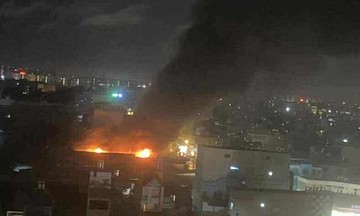At 7 a.m. on 18/7, Typhoon Wipha had sustained winds of 74 km/h (category 8) with gusts reaching category 10, moving northwest at 20 km/h, according to the National Center for Hydro-Meteorological Forecasting. By the morning of 19/7, the typhoon is expected to be over the northeastern area of the South China Sea, with winds of category 8-9 and gusts up to category 11. It will continue moving northwest at 20-25 km/h and likely strengthen.
By 7 a.m. on 20/7, the typhoon may reach category 10, with gusts up to category 12, and will be situated approximately 590 km east of the Leizhou Peninsula (China). On the morning of 21/7, the typhoon is projected to further intensify to category 11-12, with gusts up to category 15, while remaining east of the Leizhou Peninsula.
The Japan Meteorological Agency forecasts that the typhoon will enter the South China Sea tomorrow, moving west-northwest along the Chinese coast with maximum sustained winds of approximately 108 km/h. The Hong Kong Observatory offers a similar trajectory prediction but anticipates a higher intensity, up to 130 km/h.
From the afternoon of 18/7, the eastern area of the South China Sea will experience strong winds of category 6-7 due to the typhoon's influence, with winds near the typhoon's center reaching category 8-9 and gusts up to category 11. Waves are expected to reach 3-5 meters. Vessels operating in the area are advised to monitor the situation closely and seek shelter.
 |
Projected path and area of influence of Typhoon Wipha, morning of 18/7. Photo: NCHMF |
Projected path and area of influence of Typhoon Wipha, morning of 18/7. Photo: NCHMF
In response to the typhoon's development, the Ministry of Agriculture and Rural Development and the Ministry of Natural Resources and Environment have issued urgent dispatches to northern provinces and coastal provinces from Quang Ninh to Dak Lak. The dispatches urge close monitoring of the situation and review of safety plans for infrastructure, ports, tourism activities, aquaculture, and coastal residents.
Local authorities have been instructed to proactively prepare evacuation plans for residents in dangerous areas and ensure the readiness of rescue forces and equipment. They must also guarantee the safety of houses, warehouses, and factories, and promptly address any dike incidents.
Two typhoons have occurred in the South China Sea since the beginning of the year. Typhoon Danas did not affect Vietnam's mainland. While Typhoon Wutip in June did not make landfall, its western circulation caused heavy and prolonged rain in north-central Vietnam from 11/6 to 13/6.
The resulting floods caused 11 fatalities in Quang Binh, Quang Tri, and Hue; flooded over 3,500 houses; and impacted 88,000 hectares of crops. Dozens of locations on national and provincial highways experienced landslides and flooding. Numerous flights from Da Nang were canceled or delayed, and the finale of a beauty pageant had to be rescheduled due to rising water levels on the Perfume River.
Gia Chinh












